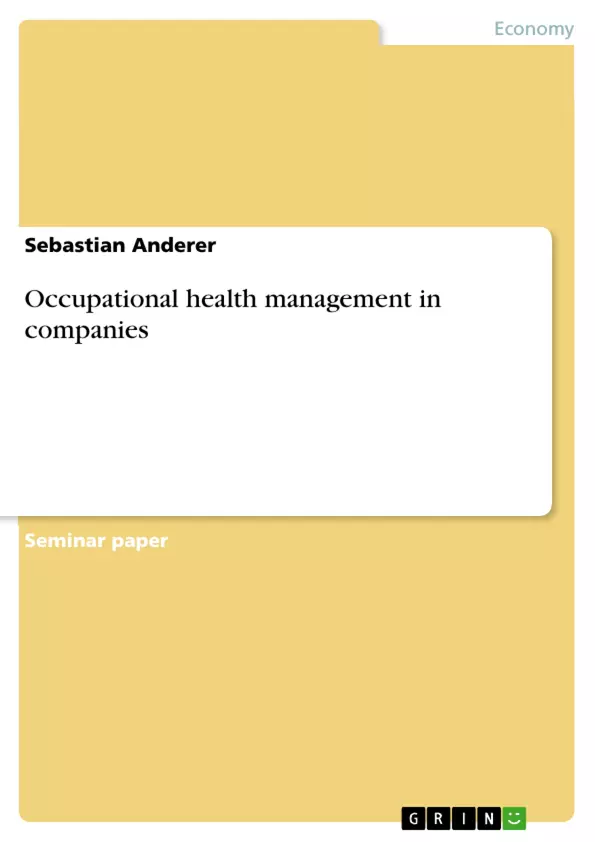This seminar paper deals with the topic of occupational health management (BGM). This topic is particularly interesting for students who want to work in a human resources department. Because coworkers of a personnel department are the main responsible persons of the BGM. The fact that there are already more than 30 bachelor's and master's degree programs in the field of occupational health management throughout Germany speaks for the high relevance of this topic in scientific theory and in practice in companies.
Today's working world is characterized by outsourcing, globalization and flexibilization, which increases the individual's health burden. The demographic change leads to the fact that the average age of the employees increases more and more. Therefore, it is of great importance to promote older employees within the framework of BGM. Due to stress at the workplace, extended working hours and a high intensity of work, the number of physical, but also mental illnesses is growing. In addition to classic illnesses such as back pain caused by long periods of sitting, depression and burn-out syndrome are on the rise. Many companies have not yet recognized the advantages of BGM and are struggling with high absenteeism and fluctuation rates. A holistic, sustainably applied BGM can increase employee motivation, reduce the number of illnesses, lower costs and improve the employer image.
In order to give a brief insight into the contents of this paper, we will discuss its structure and delimitation in the following. Due to the complexity of the topic we create first with the historical development and the definition of the terms BGF (Betriebliche Gesundheitsförderung) and BGM a basis. In the following we go into the legal framework and the involved actors of the BGM. Furthermore, we explain which instruments and measures are available to companies for the implementation of occupational health management. Subsequently, in the chapter "Benefit analysis", we discuss the intangible and tangible benefits for employees and companies. Furthermore, we show by means of a practical example that the implementation of a health management system also makes sense in small companies.
Inhaltsverzeichnis (Table of Contents)
- Introduction
- Basics of occupational health management
- Historical development
- Legal framework
- Principles
- Actors
- Instruments of occupational health management
- Occupational health report
- Risk assessment
- Employee survey
- Health circles
- Operational reintegration management
- Working Group health
- Occupational health management measures
- Nutrition program
- Company sports
- Company outings
- Stress management
- Addiction prevention and management
- Ergonomic workplace design
- Benefit analysis of occupational health management
- Benefits from the employee's point of view
- Benefits from the company's point of view
- Practical example of a BGM based on the company Rödl and Partners
- Conclusion
Zielsetzung und Themenschwerpunkte (Objectives and Key Themes)
This seminar paper delves into the topic of occupational health management (BGM), a field of growing importance for companies and individuals alike. The paper aims to provide a comprehensive overview of BGM, covering its historical development, legal framework, principles, instruments, measures, and benefits.
- Historical development of BGM and its evolution from workplace health promotion
- Legal framework surrounding occupational health management in Germany
- Instruments and measures employed in implementing BGM in companies
- Benefits of occupational health management for both employees and companies
- Practical application of BGM in real-world scenarios
Zusammenfassung der Kapitel (Chapter Summaries)
The first chapter introduces the concept of occupational health management (BGM) and outlines its significance in the contemporary world of work. It highlights the increasing burden on employee health due to globalization, outsourcing, and demographic change. The chapter emphasizes the importance of promoting employee health and well-being through BGM to combat rising stress levels, extended working hours, and the prevalence of physical and mental illnesses.
The second chapter delves into the fundamentals of occupational health management, providing a historical overview of its evolution and the legal framework that governs it in Germany. The chapter explores the principles underlying BGM and the various actors involved in its implementation, including employers, employees, and healthcare professionals.
The third chapter examines the various instruments and measures that companies can utilize to implement BGM effectively. It covers topics such as occupational health reports, risk assessments, employee surveys, health circles, operational reintegration management, and working group health.
The fourth chapter focuses on specific occupational health management measures that companies can adopt to promote employee health. These measures include nutrition programs, company sports, company outings, stress management, addiction prevention and management, and ergonomic workplace design.
The fifth chapter explores the benefits of occupational health management from both the employee's and the company's perspective. It highlights how BGM can contribute to employee motivation, reduced absenteeism, improved productivity, and a stronger company image.
Schlüsselwörter (Keywords)
The seminar paper focuses on occupational health management (BGM), workplace health promotion (BGF), employee health, stress management, legal framework, benefits analysis, and practical implementation. The paper explores key concepts such as the WHO Ottawa Charter, the European Network for Workplace Health Promotion (ENWHP), the German Network for Workplace Health Promotion (DNBGF), and the importance of sustainable structures and processes in driving BGM forward.
- Quote paper
- Sebastian Anderer (Author), 2011, Occupational health management in companies, Munich, GRIN Verlag, https://www.grin.com/document/1222617



